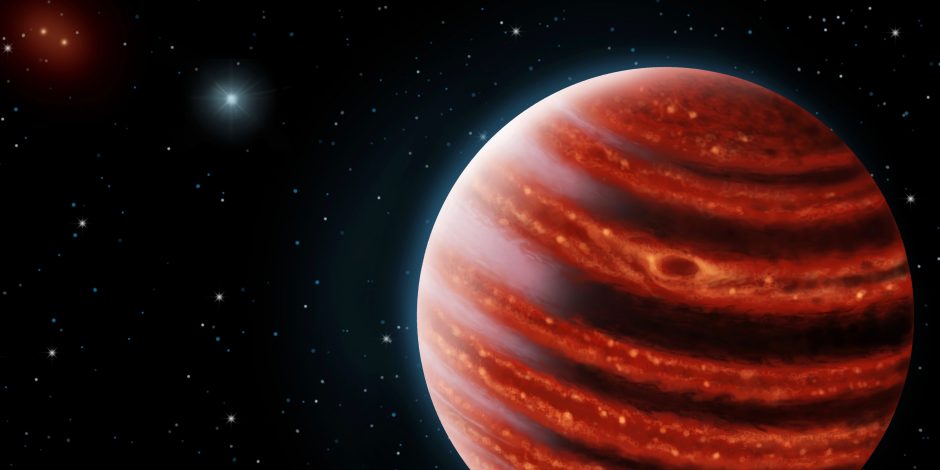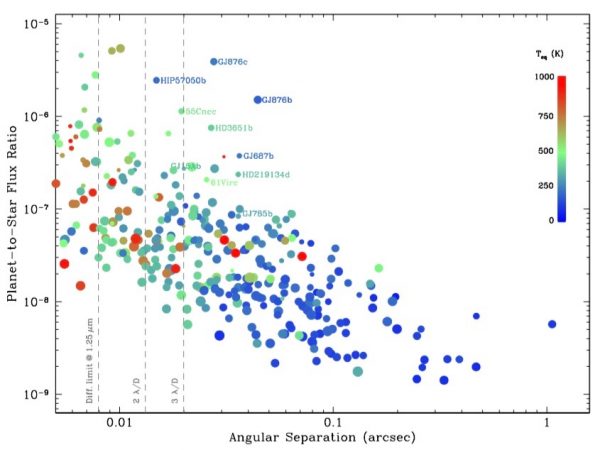PlanetS Board made its choice

Finding as many planets as possible in the close solar neighbourhood and the formation of giant planets at large orbital distances: These are the topics of the two proposals that were selected as new initiatives to be funded by the PlanetS Board. Sascha Quanz and Christophe Lovis are the authors of the first proposal, Christoph Mordasini and Ravit Helled are responsible for the second one. The NCCR Board will allocate 324’000 Swiss francs to the two projects.

Future prospects for detecting and characterizing planets around nearby stars with E-ELT/HIRES. Known exoplanets that are potentially within reach of E-ELT/HIRES if high-contrast imaging techniques are combined with high-resolution spectroscopy (cf. Snellen et al. 2015) aiming at the detection of specific molecules (e.g., CO, H2O, CO2, CH4, O2) in the planets’ atmospheres. (Figure: Quanz/Lovis)
As announced during the General Assembly in Grindelwald, PlanetS members and associates had the possibility to propose new initiatives to be funded by the NCCR. Eight proposals were submitted. In its meeting on 21 July 2016, the PlanetS Board chose two projects for funding. “We received eight very interesting proposals ranging over a wide variety of topics and with quite different long-term perspectives; choosing was not easy even with the help of our Advisory Board. However, after a long and intensive discussion we reached a consensus” says PlanetS director Willy Benz: “I am excited to see these new initiatives starting.”
209’000 Swiss francs are allocated to “The Solar Neighborhood Exoplanet Census”, a project submitted by Sascha Quanz of PlanetS research project 1 (Disks & Planets) at ETH Zurich and Christophe Lovis of project 3 (Planetary Atmospheres) at the University of Geneva. Its scientific objective is “to search for and constrain the existence of exoplanets around stars within the immediate vicinity of the Sun by means of direct imaging and/or radial velocity measurements”, the two researchers explain in their proposal.
With their project they are aiming at the future era of astronomy that will be dominated by the Extremely Large Telescopes such as the European 39-m ELT. Members of PlanetS are strongly involved in the development of the E-ELT instruments named METIS and HIRES. The ultimate goal of the new initiative is to build the best possible exoplanet sample for direct, spatially-resolved characterization with METIS and HIRES. “Therefore, we must find as many planets as possible in the close solar neighbourhood”, the researchers summarize: “This is the heart of the present proposal.” The project should also provide the scientific foundation in Switzerland for the synergy between the two instruments.
The money now allocated will be used to pay the salary of a postdoc for two years. “Given the scope of the project and in order to strengthen the link between ETH and Geneva, the position is planned as a joint assignment between the two institutions,” Sascha Quanz and Christophe Lovis write. “This initiative is certainly only the first step towards deriving the “Solar neighborhood exoplanet census” and getting ready for the future,” Sascha Quanz adds: “There are several sub-projects that we have in mind and that we will need to address step-by-step in the coming 5+ years, but thanks to the NCCR we are in an excellent position to start tackling the first challenges in the coming 2-3 years.”
The role of disk instability in planet formation

Artistic conception of 51 Eri b, a Jupiter-like exoplanet at a large orbital distance. (Image: Danielle Futselaar & Franck Marchis, SETI Institute)
115’000 Swiss francs are allocated to a project that wants to find out whether the formation of giant planets at large orbital distances can be explained by the so called disk instability model. It suggests that planets form very rapidly from the self-gravitational collapse of a large patch of gas in the protoplanetary disk. The proposal was submitted by Christoph Mordasini of PlanetS research project 5 (Formation & Evolution) at the University of Bern and Ravit Helled of project 6 (Numerical Laboratories) at the University of Zürich. The researchers want “to advance the disk instability model of planet formation to a level of maturity where it can be quantitatively and statistically compared with observations”, as they state in their “proposal for disk instability population synthesis”.
The giant planets in the Solar System and the majority of exoplanets are thought to have formed by core accretion (CA). But for planets at large orbital distances, the formation timescale via CA exceeds the disk’s lifetime. In the past years, such young self-luminous giants at large orbital distances have already been detected and their number is expected to grow further. Could they have been formed by disk instability? This is the question the new initiative should answer. The money now allocated will be used for a joint University of Bern – University of Zürich PhD position. Details can be found on the NCCR website: PhD position in theoretical astrophysics.
For the other six proposals the Board’s decision does not necessarily mean the end before the start. Some might be realized at a later time or within other budget options.
Categories: Internal Newsletter
